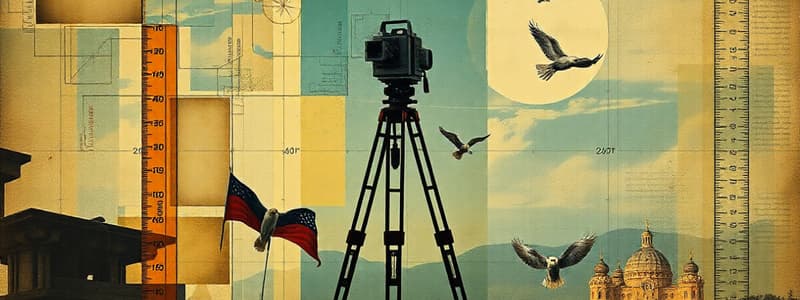Podcast
Questions and Answers
What is the primary purpose of surveying in construction?
What is the primary purpose of surveying in construction?
- To determine the relative position of features on earth (correct)
- To conduct marketing analysis for real estate
- To create aesthetic designs for buildings
- To select appropriate construction materials
Which of the following methods is considered a direct method of linear measurement?
Which of the following methods is considered a direct method of linear measurement?
- Applying theodolite with stadia
- Measuring with a transit
- Using a GPS device
- Using a tape measure (correct)
What percentage of the final grade is attributed to assignments and seatwork?
What percentage of the final grade is attributed to assignments and seatwork?
- 25%
- 100%
- 50% (correct)
- 75%
Which surveying technique is used to understand the curvature of the Earth?
Which surveying technique is used to understand the curvature of the Earth?
What type of curve is used when designing roads to ensure a smooth transition between straight and curved paths?
What type of curve is used when designing roads to ensure a smooth transition between straight and curved paths?
What is considered an indirect method of measuring distances in surveying?
What is considered an indirect method of measuring distances in surveying?
What is the role of structural engineers in relation to surveying in construction?
What is the role of structural engineers in relation to surveying in construction?
Which type of survey is critical for understanding water bodies for construction projects?
Which type of survey is critical for understanding water bodies for construction projects?
What does the standard error of the mean estimate?
What does the standard error of the mean estimate?
What is the purpose of the probable error (PE)?
What is the purpose of the probable error (PE)?
Relative precision expresses which of the following?
Relative precision expresses which of the following?
In the context of measuring distances, which factor directly involves measurement errors due to environmental changes?
In the context of measuring distances, which factor directly involves measurement errors due to environmental changes?
Which type of measurement error is related to the physical characteristics of the tape being used?
Which type of measurement error is related to the physical characteristics of the tape being used?
What is indicated by a higher standard error of the mean?
What is indicated by a higher standard error of the mean?
If the probable error of the mean measurement is calculated, what does this typically inform about the dataset?
If the probable error of the mean measurement is calculated, what does this typically inform about the dataset?
Which of the following statements is incorrect regarding taping errors?
Which of the following statements is incorrect regarding taping errors?
What significant survey method did Egyptian surveyors create to relocate land divisions?
What significant survey method did Egyptian surveyors create to relocate land divisions?
Which type of survey considers the curvature of the earth?
Which type of survey considers the curvature of the earth?
What is the maximum area for which plane surveying can typically be applied?
What is the maximum area for which plane surveying can typically be applied?
What does a hydrographic survey primarily focus on?
What does a hydrographic survey primarily focus on?
Which technology is NOT typically associated with aerial surveying?
Which technology is NOT typically associated with aerial surveying?
What is the main purpose of a topographic survey?
What is the main purpose of a topographic survey?
Route surveys are primarily used for which type of projects?
Route surveys are primarily used for which type of projects?
In what way does a ground survey differ from an aerial survey?
In what way does a ground survey differ from an aerial survey?
What is the primary purpose of a cadastral survey?
What is the primary purpose of a cadastral survey?
Which of the following instruments measures horizontal and vertical angles?
Which of the following instruments measures horizontal and vertical angles?
How is scale defined in the context of surveying?
How is scale defined in the context of surveying?
What best describes the difference between accuracy and precision in measurements?
What best describes the difference between accuracy and precision in measurements?
Which method would likely be the least accurate when measuring distance?
Which method would likely be the least accurate when measuring distance?
What type of distance measurement is considered fundamental to surveying?
What type of distance measurement is considered fundamental to surveying?
Which of the following statements about surveying instruments is NOT true?
Which of the following statements about surveying instruments is NOT true?
When using the pacing method for distance measurement, what is primarily measured?
When using the pacing method for distance measurement, what is primarily measured?
What is the coefficient of thermal expansion of the steel tape used in these measurements?
What is the coefficient of thermal expansion of the steel tape used in these measurements?
What pull is determined when the corrected distance A to B is 318.012m using a tape with standard tension of 5.5kg?
What pull is determined when the corrected distance A to B is 318.012m using a tape with standard tension of 5.5kg?
In Example 4, which factor contributes to the error in measurements due to temperature change?
In Example 4, which factor contributes to the error in measurements due to temperature change?
What is the measured distance between B and C before any corrections are applied in Example 1?
What is the measured distance between B and C before any corrections are applied in Example 1?
What is the sag correction needed for a tape supported only at its ends under a steady pull in Example 3?
What is the sag correction needed for a tape supported only at its ends under a steady pull in Example 3?
Using the slope correction formula, what is the primary variable needed to determine the horizontal length of a line?
Using the slope correction formula, what is the primary variable needed to determine the horizontal length of a line?
What is the effect of the tape's weight on the measurements when a pull of 8kg is applied?
What is the effect of the tape's weight on the measurements when a pull of 8kg is applied?
What is the corrected length of the line if the same tape standardized is found to be too long by 0.0025m?
What is the corrected length of the line if the same tape standardized is found to be too long by 0.0025m?
Flashcards are hidden until you start studying
Study Notes
Measurement Concepts
- Standard Error of the Mean (SEM): Indicates the precision of multiple measurements; shows how close the average of repeated measurements is to the true value.
- Probable Error (PE): Estimates the range in which the true value of a measured quantity is likely to fall; accounts for absolute errors of half the measurements.
- Relative Precision (RP): Expresses the consistency of a set of measurements relative to their size; indicates how precise measurements are as a proportion of their value.
Surveying Basics
- Purpose of Surveying: Involves measuring distances, angles, and positions on or near the Earth’s surface to inform construction and design plans.
- Methods of Measurement:
- Direct Measurement: Utilizing tools like tape or chain.
- Indirect Measurement: Using devices such as theodolites, transits, and GPS.
Types of Surveys
- Ground Survey: Directly measures surface features, divided into:
- Plane Survey: Assumes the land surface is flat; suitable for small areas.
- Geodetic Survey: Considers Earth's curvature; accurate for larger areas.
- Aerial Survey: Collects geographical data using airborne technology.
Types of Plane Surveys
- Topographic Survey: Maps the natural and man-made shapes of terrain.
- Hydrographic Survey: Assesses underwater features and depths of water bodies.
- Route Survey: Plans and controls land strips for infrastructure like highways and railways.
- Cadastral Survey: Determines property boundaries.
- Construction Survey: Assists in layout for building projects.
Surveying Instruments
- Steel Tape: Measures distances; includes corrections for various conditions.
- Level and Rod: Used for measuring elevation differences.
- Theodolite: Measures both horizontal and vertical angles.
- Total Station: Combines functions of the theodolite and EDM for comprehensive measurements.
Tape Correction Factors
- Incorrect Tape Length: Affects measurement accuracy; tapes can be too long or short.
- Temperature and Pull: Must be adjusted for to ensure proper tension and length during measurements.
- Sag and Slope: Corrections applied to account for gravitational effects and tilting of the tape.
Accuracy vs Precision
- Accuracy: Proximity of measurements to a true value.
- Precision: The consistency of repeated measurements; closer results imply higher precision.
Measurement Distance Types
- Horizontal Distance: Distance measured along a flat plane.
- Vertical Distance: Height difference between two points.
- Slope Distance: Length between points along a sloped surface.
Common Measurement Methods
- Pacing: Rough estimation by counting steps.
- ODOMETER and TAPING: Standard methods for determining lengths.
- Electronic Distance Measurement (EDM): Provides accurate distance calculations.
Notable Historical Context
- Egyptians (1400 BC): First known users of surveying techniques for land division post-flooding; employed ropes with knots for measurements.
Correction Examples
- Calculating temperature influences on measurements and tensions affecting steel tape based on thermal expansion coefficients.
- Understanding effects of sag and tension on length adjustments for accurate readings.
Grading System for Surveying Course
- Prelims: 25% class standing
- Midterms: 25% attendance and recitation
- Finals: 50% consisting of assignments, quizzes, and field activities.
Course Outline Highlights
- Topics range from elementary surveying basics to advanced techniques like route surveying and hydrographic surveying, emphasizing practical applications in construction and mapping.
Studying That Suits You
Use AI to generate personalized quizzes and flashcards to suit your learning preferences.




